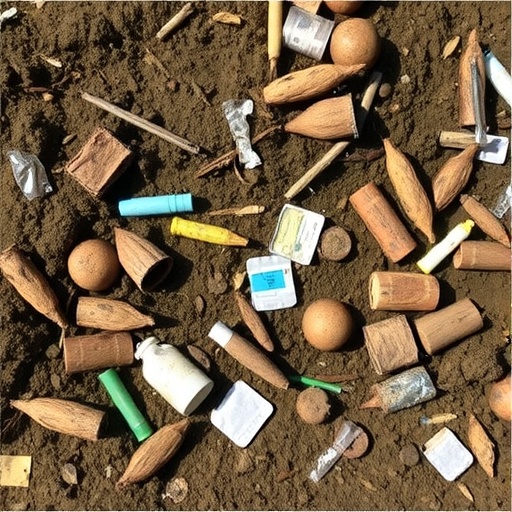In an alarming revelation, the study conducted by Mahreen, L., A. C., and Warrier, A.K. sheds light on the pervasive issue of microplastic contamination in agricultural soils along the coastal regions of Karnataka and Goa, Southwestern India. This revolutionary research highlights the alarming presence of microplastics in soils that are not just crucial for agriculture but also integral to the ecological balance of the region. As we dive deeper into this research, we uncover the implications of microplastic pollution on agriculture, human health, and the environment itself.
Microplastics, defined as plastic particles smaller than 5 mm, have penetrated various ecosystems and are now a prevalent concern for environmental scientists across the globe. The study bridges a significant gap in our understanding by providing a comprehensive assessment of microplastic levels specifically in agricultural soils in India, an area that has remained largely underexplored. This research marks a pivotal moment, drawing attention to the intersection of agricultural health and environmental contamination while simultaneously urging further exploration into this growing crisis.
The researchers employed rigorous methodologies to assess microplastic contamination in these regions, including systematic sampling across diverse agricultural locations. Utilizing advanced analytical techniques allowed them to identify and quantify microplastic pollutants effectively. Their meticulous approach not only underscores the importance of scientific rigor in environmental assessments but also sets a precedent for future studies aiming to address similar global issues.
Within the findings, the researchers disclosed various types of microplastics detected, ranging from fibers and fragments to microbeads. The diversity in microplastic types signifies the complex origins of these pollutants in the agricultural landscape. Furthermore, their study suggests that agricultural practices could further exacerbate the presence of microplastics in soils, highlighting a critical link between human actions and environmental degradation.
As the research unfolded, it became evident that the sources of microplastics in these agricultural lands were multifaceted. Possible contributors include urban runoff, agricultural inputs such as fertilizers and pesticides, and even atmospheric deposition. With these insights, the authors implore policymakers to take immediate action, as the implications of such pervasive contamination can lead to plant uptake of microplastics, potentially entering the human food chain.
The health ramifications associated with microplastics have generated much debate in scientific communities. The potential impacts on human health through the consumption of crops grown in contaminated soils cannot be overstated. It raises fundamental questions about food safety and public health, igniting a passionate discourse on the responsibilities of agricultural sectors, consumers, and regulatory bodies alike. The authors emphasize the need for increased awareness and education regarding microplastics, not just among farmers but across all sectors of society.
Moreover, the findings of this investigation play a pivotal role in educating the public about the importance of sustainable agricultural practices and the necessity of reducing plastic usage in daily life. The farmers, often seen as the custodians of the land, need to be integral players in combating this contamination issue through eco-friendly agricultural practices. The research calls for a collaborative approach involving farmers, scientists, and policymakers to develop efficient strategies to mitigate microplastic runoff into agricultural lands.
The environmental implications of microplastic contamination extend beyond agricultural soils. These pollutants can adversely affect the broader ecosystem, impacting soil health, plant growth, and ultimately the entire food web. The intricate relationships between soil microbes, plants, and surrounding wildlife could face severe disruption due to the pervasive presence of microplastics. As this ongoing research underscores the need for further ecological assessments, it becomes increasingly clear that microplastics are an urgent environmental issue that demands immediate and sustained attention.
What is particularly alarming is the continuous increase in microplastic generation and their longevity in the environment. Unlike organic pollutants that tend to degrade over time, plastics enter a cycle of persistent pollution, posing long-lasting threats to ecological systems. The researchers advocate for stringent regulations on plastic production and waste management to curb this insidious pollution, urging governments to take a stand in the fight against plastic waste.
This groundbreaking study, published in the journal Environmental Monitoring and Assessment, not only contributes to the scientific understanding of microplastics in agricultural settings but also holds the promise of galvanizing efforts towards a cleaner and healthier environment. By positioning itself at the forefront of environmental research, this paper serves as a crucial call-to-arms, prompting an urgent discussion about the prevention of microplastic pollution before it amplifies into a crisis beyond recovery.
In conclusion, the baseline assessment of microplastic contamination in agricultural soils in Karnataka and Goa serves as a wake-up call. It emphasizes a pivotal moment for the agricultural and environmental communities to collaborate in researching, managing, and solving pollution issues stemming from microplastics. The path forward requires not only scientific inquiry but also societal change, public awareness, and robust government policies. The health of our soils—and in extension, our health—is a delicate balance that requires immediate action to ensure a sustainable future for generations to come.
As more studies unfold in this area, and as the findings become widely known, awareness will continue to grow, shaping the narrative around our interaction with plastics and their impact on agriculture and the environment. Ultimately, the story of microplastics in agricultural soils is one of interconnectedness—a reminder of how human actions ripple through nature, affecting everything from soil health to food safety and environmental integrity.
Subject of Research: Microplastic contamination in agricultural soils from coastal Karnataka and Goa
Article Title: Baseline assessment of microplastic contamination in agricultural soils from the coastal stretches of Karnataka and Goa, Southwestern India
Article References:
Mahreen, L., C, A. & Warrier, A.K. Baseline assessment of microplastic contamination in agricultural soils from the coastal stretches of Karnataka and Goa, Southwestern India.
Environ Monit Assess 197, 1053 (2025). https://doi.org/10.1007/s10661-025-14513-5
Image Credits: AI Generated
DOI: 10.1007/s10661-025-14513-5
Keywords: Microplastics, agriculture, soil contamination, Karnataka, Goa, environmental assessment, food safety.




